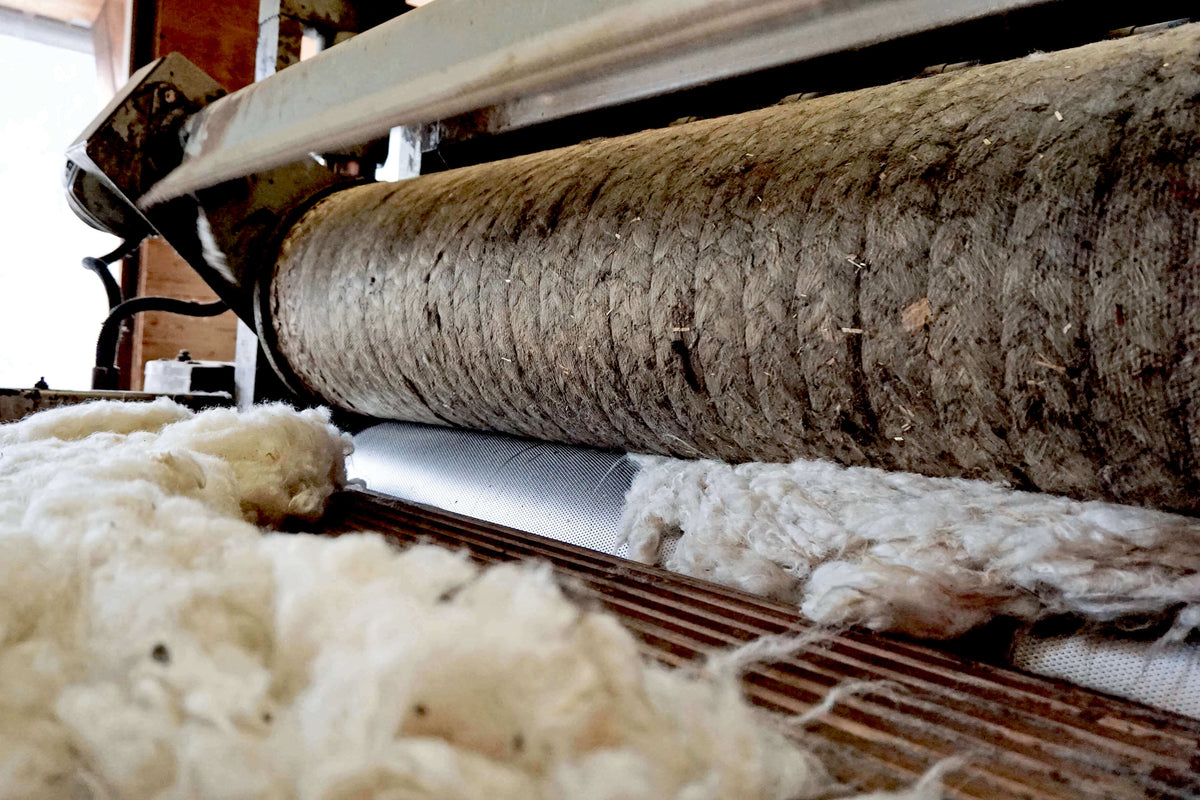

"We love wool and its natural functions. Therefore, it is a logical step for us not only to use wool in hoodies or jerseys, but also to incorporate wool insulation in our warming jackets and vests."
Lavalan Wool Insulation is a filling made from 100% natural and renewable raw materials. It combines the unique properties of sheep's wool with the easy-care characteristics of corn-based polylactide fibers (PLA). However, for this wool insulation, the wool must be processed into a light and airy fleece to achieve an insulating effect. This requires a lot of know-how. But of course, wool is essential. To obtain the raw material wool through short supply chains, it comes from sheep breeders in Switzerland (Disentis) and Norway (Gol). After shearing, the wool is transported to wool collection points and initially sorted. For the fleece of the Wool Insulation, relatively coarse wool is used, which would not be suitable for jerseys or hoodies.
The path of isolation made of wool
"After collection, the Swiss wool bales make their way to Belgium (Traitex) and the Norwegian wool to the UK (Haworth). Here, the wool is cleaned of the dirt from the pastures using soap and soda. Only in Belgium and England are there the old, unique machines and decades of know-how to gently wash the wool and equip it with a non-felting finish. The basis for our wool insulation."
Subsequently, the wool is transported to the south of Germany. In Dinkelsbühl, at the traditional company Baur Vliesstoffe, the wool is opened, carded, cross-laid, and then thermally solidified through a sophisticated process. This results in fleece rolls that are available in different thicknesses and densities. The wool insulation as fleece is then processed in Croatia into the high-performance TRIPLE2 insulation products.
No chance for synthetic materials
"Synthetic materials are often used for the insulation of textiles. However, nature already provides highly functional and complex raw materials. Insulation made from wool is one such natural 'high-tech' fiber that offers many advantages:"
Wool insulation is capable of absorbing and releasing up to 36% of its dry weight in vapor form. At the same time, wool insulation is water-repellent. This makes Lavalan wool insulation very breathable, quick-drying, and always provides a pleasant, cozy warmth - even when damp.
Since the insulation made of wool is temperature-regulating, it also has a cooling effect and protects against overheating during intense activity or unexpectedly high temperatures. Another unique advantage is odor neutralization. Our wool insulation prevents the formation of bacteria that are responsible for bad odors. Thus, simple airing is sufficient and allows for longer use without unnecessary washing.
Better than down?
Primarily, wool insulation works even when it is wet, unlike synthetic fibers or down. Our wool fleece is also so stable due to its structure that it does not form clumps when exposed to moisture and retains its full insulation performance.

How do I wash wool insulation?
Even though wool has a self-cleaning effect and only starts to produce unpleasant odors after prolonged use, your wool insulation will eventually need to be washed. Unlike down or synthetic fibers, washing wool insulation is not a problem. You will need a wool detergent and a washing machine with a wool wash program. Close all zippers on your product and wash it on the wool cycle. Afterwards, it's best to lay it flat on a drying rack and let it dry. Your insulation will be fresh and fully functional again.

Isolation made of wool from Europe
Our wool comes exclusively from sheep from all over Europe. They graze in the idyllic surroundings of the Austrian and Swiss Alps or are kept under natural conditions on extensive pastures in Norway and Sweden. Our sheep always have access to pure and diverse nature, clean water, and fresh grass. Even though temperatures in the mountains or in the harsh Scandinavian climate can fluctuate from below zero at night to 30° during the day, their fleece protects them from the elements, keeps them cool in warmth, and provides cozy warmth in the cold. The independent Swiss company UniqueTrace certifies our supply chain, allowing us to trace the origin of our wool insulation from the sheep to the finished product.
protection of animals
The European Union, but especially Switzerland and Norway, are among the countries with the strictest animal welfare standards in the world. The legislator sets strict rules in the areas of feeding, housing, good health, and appropriate behavior, always taking into account the respective sex and age of the animals. Sheep should always be kept in a way that their bodily functions and behavior are not disturbed and their adaptability is not overwhelmed. For example, accommodations and enclosures must be equipped with suitable feeding, drinking, feces, and urine areas, as well as resting and retreat areas. Stables must be equipped with a covering, enrichment opportunities, facilities for grooming, and climatic areas. Mulesing (see also article on Merino) is not practiced in Europe because the fly larvae only spread in warmer countries. The wool of Lavalan products is therefore 100% Mulesing Free. For Lavalan, it is a matter of course that no animals are tortured, neither during keeping nor during shearing.

Can I trace where the wool for the wool insulation comes from?
"That's not a problem. Our products that contain our Lavalan insulation made from wool come with a tracing code. With this code, you can precisely track on the website where the wool comes from, how it is processed, and ultimately where it serves its purpose in one of our products. We place great importance on a completely European origin of our materials."
No code at hand? All products with Lavalan wool insulation can be tracked using this code:
WD3VM
Where does the wool come from?
"With the Lavalan wool insulation combined with the tracing functionality, we can present the complex supply chain to you in detail."